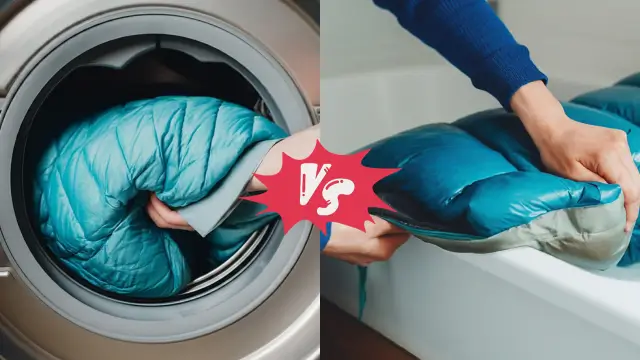How To Wash a Down Sleeping Bag: A Comprehensive Guide
Introduction
As an avid camper and outdoor enthusiast, I understand the importance of maintaining your gear, especially something as crucial as your down sleeping bag.
I’m Jaden Burley, and in this comprehensive guide, you’ll discover how to wash a down sleeping bag, which includes two methods: machine washing or hand washing.
Importance of Properly Washing Down Sleeping Bags
Your down sleeping bag is not just a piece of outdoor equipment; it’s your cozy refuge in the wild. Regular washing is not just about cleanliness; it’s a crucial aspect of gear maintenance.
A clean sleeping bag ensures a longer lifespan, improved insulation, and a healthier sleeping environment during your outdoor escapades.
Prolonging the Lifespan of Your Sleeping Gear
Proper care translates to longevity. A well-maintained down sleeping bag retains its loft, keeping you warm on chilly nights.
Neglecting regular cleaning can lead to a decrease in insulation effectiveness and, eventually, a shorter lifespan for your beloved sleeping companion.
Read more about: How Long Do Sleeping Bags Last
Common Mistakes and How They Affect Your Down Sleeping Bag
Before we dive into the washing process, let’s address common mistakes. Using the wrong detergent, improper drying, and neglecting stains can impact the performance of your sleeping bag. This guide aims to equip you with the knowledge to avoid these pitfalls.
Essential Materials and Tools
Choosing the Right Soap for Down Sleeping Bags
Not all soaps are created equal. Opt for a down-specific cleaner, such as Grangers Down Wash, Gear Aid ReviveX Down Wash, or Nikwax Down Wash, to ensure the preservation of natural oils and the integrity of the insulation.
Avoid harsh chemicals that can strip the down of its loft and water-resistant properties.
The Benefits of Using a Large Front Loading Washing Machine
Large front-loading machines are gentler on your sleeping bag compared to top-loading counterparts.
They provide a spacious drum, reducing friction on the delicate down clusters. Additionally, the absence of an agitator minimizes the risk of damage during the wash.
Hand Washing vs. Machine Washing

Pros and Cons of Each Method
Hand washing allows for meticulous care, but it can be time-consuming. On the other hand, machine washing is convenient but requires careful consideration of machine type and settings.
We’ll explore both methods to cater to your preference and available resources.
Step-by-Step Guide for Hand Washing
- Preparation: Fill a bathtub with lukewarm water and add the down-specific cleaner.
- Gentle Agitation: Submerge the sleeping bag and gently agitate it. Pay extra attention to soiled areas.
- Rinsing: Drain the soapy water and refill the tub with clean water. Rinse the bag until all detergent is removed.
- Pressing Out Excess Water: Gently press the water out without wringing to avoid damaging the delicate down.
Tips for Using a Front Loading Washing Machine
- Prep & Read: Check the bag label for instructions. Turn it inside out, zip up, and load into a front/top-load washer without an agitator.
- Machine Setup: Ensure no foreign objects in the washer. Use special down soap; avoid regular detergent. Optional: add Down Proof for extra feather protection.
- Load Balancing: Ensure an even distribution of the sleeping bag inside the machine.
- Gentle Cycle: Opt for a delicate or hand wash cycle to minimize agitation.
- Extra Rinse: Run an additional rinse cycle to guarantee detergent removal.
Choosing the Right Water Temperature and Cycle Settings
Stick to lukewarm water to prevent damage to the down. Choose a gentle cycle, and if available, an extra rinse cycle to eliminate any lingering detergent.
Drying Techniques for Down Sleeping Bags

Tumble Drying: Dos and Don’ts
- Low Heat: Use a low-heat setting to prevent damage to the down.
- Tennis Balls or Sneakers: Add 3-6 tennis balls or sneakers for fluffiness when nearly dry (they generally take 3-5 hours to dry completely).
Air-Drying: Ensuring Thorough Drying Without Damage
- Flat Drying: Lay the sleeping bag flat on a clean, dry surface.
- Regular Fluffing: Periodically fluff the down by hand to prevent clumping.
Importance of De-clumping and Fluffing During Drying
Clumped down equals decreased insulation. Regularly check and gently separate any clumps during the drying process to maintain optimal loft.
Special Considerations for Down Sleeping Bags
Avoiding Dry Cleaning and Top-Loading Machines
Dry cleaning chemicals can compromise the down’s natural oils. Top-loading machines with agitators pose a higher risk of damage due to their design.
Understanding DWR (Durable Water Repellent) Restoration
Down sleeping bags often come with DWR coatings for water resistance. After washing, use a reputable DWR restorer to enhance water repellency.
Spot Cleaning Techniques for Specific Stains
For stubborn stains, spot cleaning is the way to go. Use a mild soap and a soft cloth to gently dab the stained area.
Dealing with Mold and Mildew Issues
Prevent mold and mildew by ensuring your sleeping bag is thoroughly dry before storage. If mold does appear, treat it with a mixture of water and vinegar.
Maintenance Tips for Prolonged Performance
How Often Should You Wash Your Down Sleeping Bag?
The frequency depends on use. A general rule is to wash it after 20 nights of use or when it noticeably loses loft.
Using Liners and Specially-Formulated Products for Spot Cleaning
Invest in a sleeping bag liner to minimize direct contact with body oils and dirt. Spot clean between washes using down-specific cleaning products.
Preserving Your Investment in Quality Sleeping Gear
Your down sleeping bag is an investment. Proper care ensures it remains a reliable companion on countless adventures. Store it uncompressed in a breathable bag in a cool, dry place.
Expert Tips for General Sleeping Bag Care
Beyond Washing: Maintaining Your Sleeping Bag for Longevity
Regularly shake out your sleeping bag during trips to maintain loft. Air it out after each use to prevent odors.
Storing Your Down Sleeping Bag Properly
Store your sleeping bag in a large, breathable sack, avoiding compression. This ensures the down retains its loft and overall effectiveness.
Frequently Asked Questions
1. Can I Use Normal Detergent?
Avoid using regular detergent, as it can strip the down of its natural oils and water-resistant properties. Stick to down-specific cleaners.
2. Is Dry Cleaning a Viable Option?
Dry cleaning chemicals can damage the down and should be avoided.
3. Insights on Washing Frequency
Wash your sleeping bag after approximately 20 nights of use, or when it loses loft.
4. How to Wash a Down Sleeping Bag with a Zipper or a Hood?
Zip up the bag and secure the hood, ensuring even washing. Pay special attention to these areas during the cleaning process.
5. How to Wash a Synthetic Sleeping Bag?
While this guide focuses on down sleeping bags, synthetic bags usually have specific care instructions on their tags. Follow those guidelines for optimal cleaning.
Conclusion
In conclusion, the key to a long-lasting and high-performing down sleeping bag lies in proper care and maintenance.
By following these comprehensive guidelines, you’re not only ensuring a clean and cozy night’s sleep but also extending the life of your valuable outdoor gear.
Regular washing, thoughtful drying, and meticulous care are the secrets to making the most out of your down sleeping bag on every adventure.